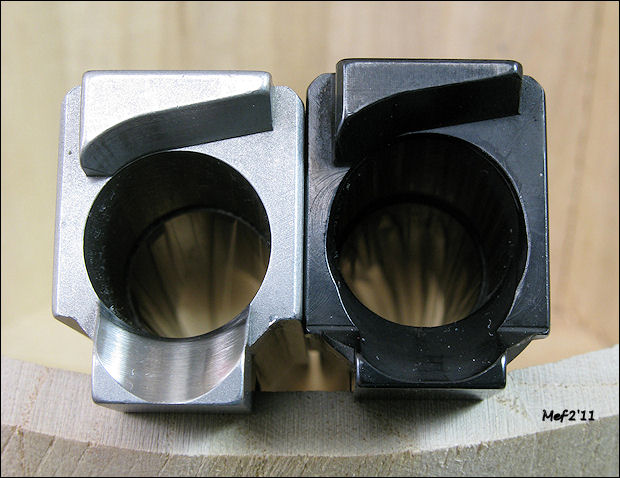message board home
 6/25/2018 3:32:53 PM
6/25/2018 3:32:53 PM
 Reply
or ReplyNewSubject
Reply
or ReplyNewSubject
Section 16: Gun Work Subject: 1911 Barrel Throats Msg# 1018072
|
||||||
You're right, Stu. 
Guys, I got to looking at this photo when it popped up on the home page photo array. I believe this throating pattern was originally adopted for 185gr target semi-wadcutters--which of course are a rather low profile truncated cone bullet in .45ACP, noticeably lower than the old H&G #68 SWC we all used to shoot, which had a longer bearing surface. It worked well for the H&G #68 as well, and for most JHPs. But the way a .45ACP feeds out of a 1911 is that it comes up at about 30 or even 40 degree angle and bumps into the underside of the barrel hood, then down into the chamber. The idea that it releases smoothly from the magazine, slides up the feed ramp and into the chamber is inaccurate. This is all controlled by the magazine and the mag's feed lips initially of course, and a GI Ball magazine won't release the round until the last possible nano-second. It bounces off the underside of the hood and then is right there to slide up that very narrow GI throat and into the pistol. Target SWCs and JHPs are generally used with magazines that release the round so early you might still be parking your car at the range. (1911s have controlled round feeding like a Mauser 98 bolt action rifle, of course. This is one reason the 1911 is more reliable in combat than some of your newer boutique-type plastic jobs that lack controlled round feeding. Try shooting those pistols upside sideways and in every other attitude under combat conditions then brag about your plastic fantastic. At any rate, it seems to me that most pistols don't really need that uber wide barrel throating as shown in the photo. Does it hurt anything? There's the rub. In a low pressure chambering it does not. Get out your 9mms and 10mms and Supers and look at your barrel throating. With the barrel removed from the slide, drop a loaded round into the barrel and see how much of the round is visible, i.e., unsupported. It might be surprising. Oh--note I'm not talking unsupported like a Glock. Glocks would, to describe it in an exagerrated way take a chamber intended for a cartridge nine millimeters in diameter and make the chamber 10 millimeters in diameter--in other words, sloppy fit was the name of the game. Here's a custom Glock barrel that is tight and does offer a supported chamber on the left with a normal factor Glock chamber on the right showing how sloppy loose they are on the right: Image below from Mark Freburg - Image Title: Glock barrels  Here's the same barrels empty, the difference is obvious:
Image below from Mark Freburg - Image Title: Glock barrels Image Info: Lone Wolf .45ACP G21 barrel in silver, left, Glock 21SF stock barrel in black, right. Note the significant differences in chamber size.  With a 1911 you don't have this kind of SLOPPY chamber fit Glock's famous for, but they do expose the cartridge at the rear, and excessive throating can increase the amount of exposure. Take your barrel out of your pistol and check it out. Just for fun....
|
||||||
|
|
||||||
|
For reference, the above message is a reply to a message where: I'll jump in here before Mark Freburg answers you. The barrel on the left looks like a pretty standard throating job based on my limited experience with both factory throated and gunsmith throated barrels. More than needed? I can't say. Stu |


